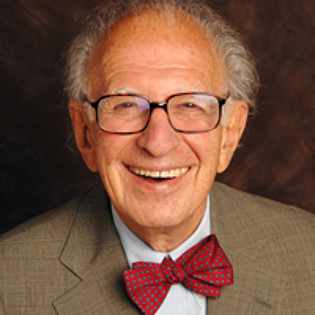Vorträge & Diskussionen
The Role of Functional Prion-Like Proteins in the Persistence of Memory: A Perspective

Leopoldina Lecture by the Nobel laureate and Leopoldina member Eric R. Kandel
| Date: | Friday, 27 May 2016 |
| Time: | 18:30 to 20:00 |
| Location: | Humboldt-Universität zu Berlin, Audimax, 10117 Berlin |
Prions are proteinaceous infectious agents that were discovered in the 1980s by Stanley Prusiner while studying Creutzfeldt-Jakob disease (Prusiner, 1982). Prusiner found that prion proteins exist in two conformations soluble and aggregated. The transition between these forms occurs spontaneously. The aggregate conformation is self-perpetuating, pathogenic and kills cells. Soon prion proteins were found to contribute to other neurodegenerative disorders in people, including Kuru, Transmissible Spongiform Encephalopathies, as well as Bovine spongiform encephalopathy in cows (Prusiner 1994; Aguzzi and Weissmann 1998). There is now a growing consensus that similar prion-like, self-templating mechanisms underlie a variety of neurodegenerative disorders including Amyotrophic Lateral Sclerosis, Alzheimer's disease, Parkinson’s disease, and Huntington's disease (Polymenidou and Cleveland, 2012).
Not all prions, however, appear to be disease producing. In 2003 Kandel together with Kausik Si discovered a prion-like protein in the nervous system of the marine snail Aplysia, whose aggregated and self-perpetuating form contributes to the maintenance of long-term changes in synaptic efficacy. In earlier work Kandel and Kelsey Martin had found that long-term memory in Aplysia is synapse-specific. Moreover the synapse-specific long-term memory requires local protein synthesis at the activated synapse. This local protein synthesis serves two functions:
- it provides a component of the mark at the activated synapse and thereby confers synapse specificity and
- it stabilizes the synaptic growth associated with long-term facilitation.
Kandel and Kausik Si next found that this synaptic protein synthesis is regulated by a neuron-specific isoform of cytoplasmic polyadenylation element binding protein (CPEB) in an activity-dependent manner. Aplysia CPEB protein is upregulated locally at activated synapses, and it is needed not for the initiation, but only for the stable maintenance of long-term facilitation.
They next explored the nature of CPEB and found it to have prion-like properties. Prion proteins have the unusual capacity to fold into two functionally distinct conformations, one of which is self-perpetuating. When yeast prion proteins switch state, they produce heritable phenotypes. Kandel and Kausik Si found similar prion-like properties in a neuronal member of the CPEB family, which regulates mRNA translation at the synapse. Compared to other CPEB family members, the neuronal protein has an N-terminal extension that shares characteristics of yeast prion-determinants: a high glutamine content and predicted conformational flexibility. When fused to a reporter protein in yeast, this region confers upon it the epigenetic changes in state that characterize yeast prions. The researchers found that it is the conversion of CPEB to a prion-like state at the stimulated synapses that maintains long-term synaptic changes associated with memory storage.
Recently Kandel and Kausik Si have extended this work in two directions:
- they searched for and found CPEB-3 as a homolog of ApCPEB in the mammalian brain and found that CPEB-3 has prion-like properties and is activated by Neuralized, an ubiquitin hydrolase.
- they next looked for a second example of prions in the mammalian brain, and found a completely new candidate – TIA (T-cell intracellular antigen). TIA has classic prion properties in yeast and serves as part of the cellular response to systemic stress. TIA serves as a sex-specific protective factor in PTSD and does so in female mice only.
In his talk Kandel will consider the emerging biology of functional prions and their various roles in brain and behavior.
Photo: Eve Vagg, Columbia University
Registration and further information
The lecture addresses a professional audience and is held in English. For registration, please use the following link:
The event ist fully booked.
Contact
Dr Katja Patzwaldt
Scientific Officer
Tel.: +40 (0)30 203 8997-431
E-Mail: katja.patzwaldt@leopoldina.org
Eric R. Kandel
The neuroscientist and Leopoldina member since 1989 won the Nobel Prize for Physiology or Medicine in the year 2000, sharing it with Arvid Carlsson and Paul Greengard. The Nobel committee honoured “their discoveries concerning signal transduction in the nervous system”. Memory and learning have been key research interests to Eric Kandel for his entire academic life.
Kandel is the Director of the Kavli Institute for Brain Science at Columbia University, Senior Investigator at the Howard Hughes Medical Institute and Co-Director of the Mortimer B. Zuckerman Mind Brain Behavior Institute. He has been awarded more than 20 honorary doctorates and he is member of many national academies of science, including the ones of the U.S., France, UK, Austria, and Germany.
